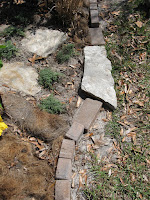 |
| May 5th's "supermoon" |
Did that
help?
 |
| If There Is Something to Desire cover |
Seems
I’m a tad edgy myself today. Blame it on syzygy.
*****
Nothing makes a garden look more
garden-ish than crisp edges. My favorite material for edging is the eight-inch-high,
heavy-duty steel stuff botanical gardens use—five inches underground, three
above, hunter green or chocolate brown, understated yet effective. The only
place I’ve ever found it for sale is by mail-order. Each twelve-foot long
section weighs in excess of a hundred pounds: prohibitive shipping costs as
well as respect for UPS drivers make it entirely unaffordable unless you
are, in fact, a botanical garden with a healthy endowment.
Over the years, Tim and I have
tried a variety of less expensive products offered by home improvement stores
and gardening catalogs. Most (excuse my French) suck. Pound-in plastic panels
balk at obstructions in the soil and shatter should you pound too vigorously.
The plastic coils (with the rolled edge to differentiate the top edge from the
bottom, reminding me of how some old ladies at the Baptist Home used to wear
their stockings) are a pain in the butt to straighten for installation. They
also develop irremediable kinks, and heave out of the ground in places, making
it look like you hired Mayberry’s Otis to do the job. (Our sympathy to Goober’s
family, by the way.) Plastic also invariably deteriorates in the presence of
ultraviolet rays, of which we have lots and lots here in southeastern North
Carolina.
 |
| See what I mean? |
Next up—the wood
blocks/pickets/faux stones stapled to rubber-like strips and the flimsy folding
metal pretend-fence sections. These you might consider for a quick cosmetic fix
when your more critical relatives descend on your homestead, but won’t last in
the long run.
Okay, then, what’s more
substantial? When Tim and I started in the business, we stacked a lot of
landscape timbers. Pressure-treated to resist damp-rot and termites, when they lay flush against
one another (once the rebar made it through the slightly misaligned pre-drilled holes and
we’d wrestled the worst of the torques into temporary submission), the result
didn’t look too bad. At least for the first two or three years. That is, if you don’t
mind straight-ish eight-foot sections, curves remaining problematic.
(Some years ago, the Perfectly Safe lobby successfully applied pressure to prohibit the
pressure-treating industry from using arsenic chromate as
termite-icide. "What if our children chew on the playground equipment?" they cried. Like there aren't any other issues at work there. So now your timber edging only lasts five years
instead of ten.)
For keeping poisonous substances
from leaching into the ground—assuming you don’t consider lime toxic—and
for preventing stoloniferous warm-season
grasses from creeping into places they are not wanted, I like the extruded
concrete that resembles curbing. Designed so lawn mowers can do their thing
right up to the, um, edge, it is not exactly a subtle touch in the landscape. At
upwards of eight dollars a linear foot, you also pay a premium for permanence. Back
when we had a lawn, Tim and I defined the beds fronting the house and
our big island this way. It saved me hours of pulling centipedegrass out of
those areas, but it is awfully white.
Natural stone edging materials include granite rip-rap irregulars, smooth river rock (we used evocatively named turtle-backs at Gen and Ed’s house—see March 17th's "The End of Deer Is Near.") and Belgian block. I covered low formed-concrete-block walls as edging on April 21, in “The Great Wall.” Dry-laid veneer stone walls are another option, but only if you have a great deal of time and patience or the wherewithal to hire a mason.
 |
| Neat, unobtrusive standing bricks |
Client projects always result in leftovers, which, as reigning Recycling Queen of North Carolina, I bring
home for domestic use. Tim used to call the messy pile of bricks and blocks my
“snake house,” but he can’t say that anymore because I’m using them to make an
eclectic edge around the New Bed.
 |
| I never claimed to be an artist, y'all |
 |
| Eclectic recycled edging materials |
With so many options to inspire us, gardeners needn’t allow their ornamental borders to wallow over into the lawn and vice-versa. Edging decreases weeding time, increases definition of that which you’d like defined, and imparts an air of caring and elegance to a landscape. If you’ll excuse me, I want to add a few more pieces from the snake house to crisp up the New Bed.
Thanks for dropping by.
Kathy




